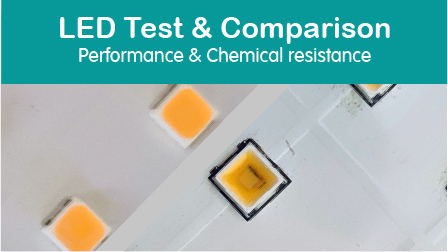What do you mean better diodes, Please elaborate. As far as i know LM301H now Evo are the best diodes available.
I will explain myself but I must warn you that this will be a very long and somewhat technical post.
We'll start with the Samsung data and ask a simple question. Why does it not add up?

The forward voltage is listed as 2.7V at 65mA which is 0.1755W. Now divide 0.56 umol/s by 0.1755W and you get 3.19 umol/j so these figures don't add up. 0.2W is really the class of LED and not the actual wattage which is why that is there.
Perhaps we should look at the LM301H Evo datasheet.

The typical voltage at 65mA is around 2.775V, which is 0.180375W and 3.10 umol/j.
You could eye the data and reach a different conclusion but it is still only published data which does not determine which bins you will get when you actually order.
Now let us compare the above with Nichia's NF2W757HT-F1 which has been superseded by the NF2W757H-V2F1 but for which we have a lot of real-world data.
Typical voltage is 2.72V at 65mA = 0.1768W. Typical lumens for CRI80 5000K is 38.1 which is 215.5lm/W. We know from our SPD data that the theoretical maximum lm/W for this diode is 328.5lm/W and its Quantum Efficiency of Radiation is 4.61 umol/j so this diode is typically 65.6% efficient for 3.02 umol/j (215.5/328.5 x 4.61).
Remember that this is a TYPICAL diode which means it is an average. There are higher flux and lower voltage bins available from Nichia but this is typically what you can expect.

Now have a look at the data for the R70 (CRI70) 5000K which is 39.6lm. I will do the maths for you. It is 224lm/W for 67% efficiency and 3.03 umol/j which is similar to the CRI80 5000K Nichia.
However, when we ordered this diode from Nichia what we actually got was a much higher flux bin than typical. What we got was P12d43 which has an average 41.1lm for 235lm/W and 68.5% efficiency for 3.15 umol/j.
These tests were done in May 2020 which is two years ago and now the new NF2W757H-V2F1 is around 4% more efficient than the older HT-F1.
We started using these diodes (and still do) in our High Light 420 Gen1 and Gen2 LED panels almost two years ago which was a year before Samsung released its Evo.
We can also look at Samsung's past claims about luminous efficiency including their LM301B which was described as being 220lm/W. But when off-the-shelf diodes were tested, they only came in at 204lm/W.
Samsung has been caught out embellishing their specs in the past and there is no reason to doubt they are still doing the same. The main difference between Samsung and Nichia is that Samsung usually quote their best figures whereas Nichia normally quote their average figures. Nichia also tends to over-deliver when you buy their diodes while Samsung can be pot-luck unless you have a good relationship with them and/or pay a premium for higher bins. The disclaimer is that we also pay a premium for top Nichia bins.
This data is almost four years old now so I don't mind sharing it. You can guess who "Company A" is because you only have to look at the diode to know it is an LM301B. The Nichia diode is an even older model, the NF2W757G-V3F1.


Now maybe Nichia is also not telling the truth but the performance of the NF2W757G-V23F1 is equal to 2.67 umol/j for CRI90 3000K according to their datasheet but when we tested the diodes they came in at 2.75 umol/j which is about 3% higher than advertised. We have found this with nearly all the Nichia diodes we have tested. They are all at typical or higher performance specs.
We could also talk about the spectrum because the EVO does have a deep blue pump in the 435-440nm range which is good but perhaps that is best left for another discussion as there are other ways to get 400-450nm light.
I just wanted to show you that you cannot always rely on advertised specs when buying LEDs off different companies.








